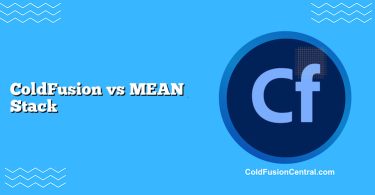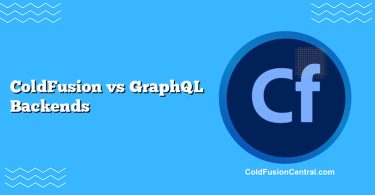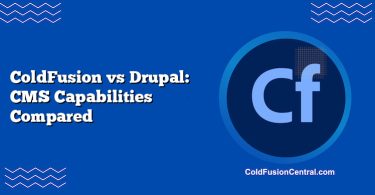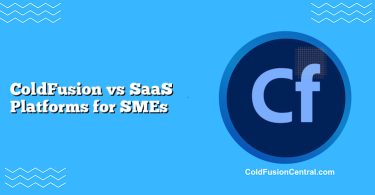Definition
What is ColdFusion (CFML)?
ColdFusion is a commercial, JVM-based application server from Adobe for building server-side web applications using the CFML (ColdFusion Markup Language). CFML resembles a mix of tags and script syntax and emphasizes rapid application development with batteries-included features like PDF generation, scheduled tasks, email, caching, and built-in security helpers. There is also a popular open-source CFML engine called Lucee, which implements most of the CFML language and runs on the JVM.
What is PHP?
PHP is a widely used, open-source server-side scripting language designed for web development. It powers a large share of the web (including WordPress, Drupal, and Magento) and has a mature ecosystem of frameworks (Laravel, Symfony) and tools (Composer, Packagist). PHP typically runs via PHP-FPM behind Nginx or Apache, and it is easy to deploy on virtually any hosting environment.
Overview
The 2025 landscape at a glance
- ColdFusion (Adobe ColdFusion 2023, with the next major release anticipated around 2025) continues to serve enterprises that value integrated features, simplified development for back-office apps, and Adobe’s commercial support. Lucee offers a free, open-source CFML runtime for teams that want CFML without the licensing cost.
- PHP 8.x (8.3 and 8.4 in the wild) remains the default choice for general-purpose web apps and CMSs. With a robust package ecosystem, modern frameworks, and features like JIT and OPcache, PHP supports both traditional monoliths and modern high-concurrency services via Swoole or RoadRunner.
Typical deployment models
- ColdFusion: JVM app server (Adobe CF or Lucee) behind a web server (IIS/Apache/Nginx), often using Tomcat under the hood; commonly containerized for DevOps pipelines; supports clustering and administrator-level tuning.
- PHP: PHP-FPM + Nginx/Apache; stateless, share-nothing architecture by default; very easy horizontal scaling; container-friendly with official Docker images.
Key Features
ColdFusion highlights
- Integrated services: PDF/image manipulation, reporting, mail, scheduling, caching, search integration.
- Rapid application development: CFML’s high-level tags (cfquery, cfmail, cfpdf) and script syntax reduce boilerplate.
- JVM foundation: Access to Java libraries; leverage JVM monitoring, GC tuning, and JMX.
- Built-in security utilities: EncodeForHTML/URL/JavaScript, cfqueryparam for SQL safety, sandbox security.
- Threading and jobs: cfthread for parallelism; scheduled tasks out-of-the-box.
PHP highlights
- Massive ecosystem: Composer dependency manager and Packagist registry; thousands of mature libraries.
- Modern frameworks: Laravel, Symfony, Laminas; batteries via packages, not core language.
- Performance tooling: OPcache, JIT (PHP 8), async via Swoole/AMP/ReactPHP; Laravel Octane for persistent workers.
- Ubiquitous hosting: Shared hosting to hyperscale cloud; official Docker images; PaaS options abound.
- CMS dominance: WordPress and Drupal power content-heavy and marketing sites with vast plugin ecosystems.
Performance
ColdFusion performance characteristics
- JVM-based runtime can be very fast when tuned (heap sizing, GC, thread pools, caches).
- Heavy built-in features make some tasks trivial but can introduce overhead if overused on hot paths.
- Cold starts can be heavier than PHP, but warmed instances perform consistently.
- Concurrent processing via cfthread can speed up I/O-bound tasks (e.g., calling multiple APIs simultaneously).
PHP performance characteristics
- Excellent request throughput with Nginx + PHP-FPM + OPcache.
- JIT in PHP 8 improved CPU-bound workloads, though web apps often benefit most from OPcache and application-level caching.
- Async worker models (Swoole, RoadRunner) enable high-concurrency, low-latency services.
- Share-nothing design avoids memory leaks across requests and eases horizontal scaling.
Benchmarks and tuning tips
- ColdFusion: Enable query caching for frequent reads, use cfqueryparam, configure EHCache/Redis where appropriate, minimize expensive tag-based operations in tight loops, precompile templates if supported, and tune JVM GC.
- PHP: Enable OPcache, use PHP-FPM static/dynamic process tuning, leverage HTTP reverse proxy caching (Varnish/Nginx), connection pooling for databases with persistent workers (Octane/Swoole), and profile hot paths with Xdebug/XHProf/Blackfire.
Scalability and Architecture
Horizontal scaling patterns
- ColdFusion: Scale with multiple JVM instances behind a load balancer; use sticky sessions or external session stores (Redis) for session persistence; use CDN and caching to reduce dynamic load.
- PHP: Designed for stateless, horizontal scale; replicate application nodes easily; externalize state to Redis/Memcached/DB; simple blue/green and canary deployments.
State and session management
- ColdFusion: J2EE sessions or ColdFusion sessions; consider replication or external stores; be cautious with sticky sessions in multi-region deployments.
- PHP: Stateless by default; sessions typically stored in Redis/Memcached or cookies; easier cross-region failover when state is external.
Microservices and serverless
- ColdFusion: Works in microservices when containerized; fewer turnkey serverless options.
- PHP: Supported by serverless frameworks (e.g., Bref on AWS Lambda); good fit for lightweight APIs and scheduled functions.
Security
Platform security features
- ColdFusion: Administrator-level lockdown guides, sandbox security, secure profile installs, built-in encoding functions (EncodeForHTML, EncodeForJavaScript), cfqueryparam for SQL injection prevention, centralized configuration via CF Administrator.
- PHP: Mature security libraries (password_hash, libsodium), frameworks with CSRF/XSS protections out-of-the-box, strict typing (8+), and secure coding guidelines via OWASP, Symfony/Laravel best practices.
Common pitfalls and hardening checklist
- ColdFusion pitfalls: Leaving the CF Administrator exposed to the internet; insufficiently restricting the admin API; not using cfqueryparam; outdated patches.
- PHP pitfalls: Directly concatenating SQL; neglecting input filtering; running outdated plugins/themes in CMS; weak file permissions.
- Hardening for both:
- Enforce TLS, HSTS, and secure cookies.
- Use prepared statements/parameterized queries.
- Centralize secrets management (Vault/SSM).
- Keep runtimes and libraries patched.
- Instrument logging, WAF, RASP, and rate-limiting.
Cost and Licensing
Upfront and runtime costs
- ColdFusion (Adobe): Commercial, per-core licensing for Standard/Enterprise editions; includes vendor support and enterprise features. Total cost can be significant for large clusters.
- Lucee: Open-source CFML engine with no license fees; enterprise support available via third parties.
- PHP: Open-source with no license fees; near-zero cost to start; hosting at every price point.
Staffing and ecosystem costs
- ColdFusion: Smaller hiring pool; experienced CFML developers often command higher rates; reduced development time for certain features may offset costs.
- PHP: Very large talent pool; abundant documentation and community support; faster ramp-up for new hires.
Tooling, Ecosystem, and Community Support
Libraries and frameworks
- ColdFusion/CFML: Built-in services reduce need for external libraries; frameworks like ColdBox, FW/1, and cfWheels; Lucee community plugins.
- PHP: Composer/Packagist, Laravel/Symfony eco-systems, PSR standards, thriving testing tools (PHPUnit, Pest), and quality gates (PHPStan, Psalm).
Hosting and cloud support
- ColdFusion: First-class on VMs and containers; official Docker images (Adobe CF) and Lucee images; fewer managed PaaS options.
- PHP: Broadest hosting support from shared providers to major clouds; managed services for WordPress/Drupal; serverless runtimes available.
Community size and longevity
- ColdFusion: Longstanding but niche; strong in government, finance, and enterprise intranets; Adobe and Lucee communities provide consistent forums and resources.
- PHP: One of the largest open-source communities; vast educational content; frequent security advisories and timely patches.
Supported Platforms
- ColdFusion/CFML:
- OS: Windows, Linux, macOS (development), containerized on any Docker host.
- Web servers: IIS, Apache, Nginx (fronted).
- Datastores: MySQL/MariaDB, SQL Server, Oracle, Postgres, NoSQL via Java drivers.
- Cloud: AWS/Azure/GCP via VMs/containers; fewer turnkey PaaS options.
- PHP:
- OS: Linux, Windows, macOS (development), official Docker images.
- Web servers: Nginx, Apache, Caddy.
- Datastores: MySQL/MariaDB, Postgres, SQL Server, SQLite, Redis, Memcached, Kafka via clients.
- Cloud: Extensive managed hosting, PaaS, and serverless support.
Side-by-Side Comparison Table
| Dimension | ColdFusion (Adobe CF / Lucee) | PHP (8.x) |
|---|---|---|
| Performance | Strong with JVM tuning; excellent for integrated tasks and multi-threaded jobs; heavier cold starts | High throughput with OPcache/FPM; async options (Swoole/RoadRunner) for extreme concurrency |
| Scalability | Scales via clustered JVM instances; consider session replication or sticky sessions | Share-nothing by default; trivial horizontal scaling; stateless microservices fit |
| Security | Built-in sanitizers and sandboxing; admin hardening required | Mature frameworks and libs; secure defaults common; vast guidance and tooling |
| Cost | Adobe CF: commercial per-core licensing; Lucee: free | Free and open-source; plentiful low-cost hosting |
| Ecosystem | Smaller but focused; frameworks like ColdBox; rich built-ins reduce dependencies | Huge package ecosystem; Composer/Packagist; many frameworks and CMSs |
| Use Cases | Enterprise back-office, reporting/PDF-heavy apps, legacy CFML modernization | CMS/content sites, e-commerce, APIs, microservices, multi-tenant SaaS |
| Pros | Rapid development; integrated services; JVM leverage | Ubiquitous hosting; massive talent pool; flexible architectures |
| Cons | Licensing (Adobe), smaller community, fewer PaaS/serverless options | Quality varies in plugin ecosystems; need to choose/assemble libraries |
Real-World Use Cases
When ColdFusion shines
- Internal enterprise apps where speed-to-delivery matters and the team values built-in features like PDF/report generation, scheduled jobs, and easy email integration.
- Organizations with existing CFML investments seeking modernization (containerizing Adobe CF or migrating to Lucee) without a full rewrite.
- Government or regulated industries that prefer vendor-backed support contracts and audit-friendly admin tools.
Example: An insurance company builds a claims processing portal that automatically generates PDFs, emails summaries to adjusters, and runs nightly reconciliation tasks. Using CFML’s cfpdf, cfmail, and scheduled tasks, the team ships the MVP quickly. They containerize Adobe CF for dev/prod parity and leverage JVM monitoring.
When PHP shines
- Content-driven sites and marketing platforms (WordPress/Drupal), where plugins, themes, and hosting options accelerate delivery.
- Startups building REST APIs and multi-tenant SaaS on Laravel or Symfony; straightforward scaling, CI/CD, and developer hiring.
- High-concurrency services using Swoole/RoadRunner or Laravel Octane for persistent workers and async I/O.
Example: A media startup launches a headless CMS using WordPress as a content backend and a Laravel-based API to power mobile apps. PHP-FPM + OPcache handle traffic spikes, and a CDN offloads static content. Hiring new developers is easy, and Composer keeps dependencies organized.
Pros and Cons
ColdFusion (Adobe CF / Lucee) Pros
- Rapid development with rich built-ins (PDF, mail, caching).
- JVM ecosystem access; leverage Java libraries and tools.
- Multi-threading via cfthread for parallel tasks.
- Vendor support (Adobe) or zero license cost (Lucee).
- Centralized admin and security sandboxing.
ColdFusion Cons
- Licensing cost for Adobe CF; budgeting required for large clusters.
- Smaller talent pool; hiring can be slower.
- Fewer PaaS/serverless options and community packages.
- Heavier runtime; careful tuning required.
PHP Pros
- Free and open-source with ubiquitous hosting.
- Huge ecosystem (Composer/Packagist) and frameworks (Laravel, Symfony).
- Great scalability with stateless design; easy horizontal scale.
- Large talent pool; quick onboarding and community support.
- Modern performance via OPcache, JIT, and async workers.
PHP Cons
- Ecosystem fragmentation; quality varies among plugins and packages.
- Security hygiene depends on dev practices; CMS plugins can be risk points.
- Feature assembly required; fewer “built-ins,” more library curation.
Decision Factors / Which One Should You Choose?
- Choose ColdFusion if:
- Your team already has CFML expertise and substantial CF assets.
- You need integrated features (PDF/reporting, email, scheduling) immediately.
- You want vendor-backed support and a cohesive admin experience.
- You can justify commercial licensing (or choose Lucee to mitigate cost).
- Choose PHP if:
- You want maximum flexibility, ecosystem breadth, and low TCO.
- You’re building content-heavy sites, SaaS, or APIs where frameworks excel.
- You expect to scale horizontally and hire developers rapidly.
- You prefer many hosting and deployment options, including serverless.
Practical decision matrix:
- Speed-to-delivery with built-in services and existing CFML codebase: lean to ColdFusion/Lucee.
- Greenfield product aiming for broad talent availability and ecosystem: lean to PHP.
- Strict budgets or startup phase: PHP wins on cost and hosting flexibility.
- Heavily regulated environments needing vendor support and auditability: Adobe ColdFusion is compelling.
- Desire to keep CFML but reduce costs: Lucee is a strong alternative.
Language Syntax and Development Experience Differences
- Paradigm:
- ColdFusion: CFML tag-based + script syntax; templating-like approach with high-level tags.
- PHP: Script-first with embedded templating; frameworks emphasize MVC and DI patterns.
- Database access:
- ColdFusion: cfquery tags with cfqueryparam; ORM available; built-in query caching.
- PHP: PDO with prepared statements; ORM via Eloquent (Laravel) or Doctrine (Symfony).
- Templating:
- ColdFusion: Native CFML templating; include/CFOUTPUT constructs.
- PHP: Blade (Laravel), Twig (Symfony), Plates; separation of concerns via frameworks.
- Concurrency:
- ColdFusion: cfthread for multi-threading tasks.
- PHP: Async/evented models via Swoole, ReactPHP, Amp, or queues (Redis/RabbitMQ).
- Dev tools:
- ColdFusion: VS Code CFML extensions, commandbox (Lucee), Adobe CF Admin.
- PHP: Composer, PHPStan/Psalm, PHPUnit/Pest, Xdebug/Blackfire, PHPStorm/VS Code.
Key Takeaways / Summary Points
- ColdFusion excels at rapid development with built-in enterprise features and JVM stability; Lucee offers a cost-effective CFML path.
- PHP dominates general web app development with a massive ecosystem, easy scaling, and abundant talent and hosting options.
- For legacy CFML or integrated reporting-heavy apps, ColdFusion/Lucee can minimize time-to-value.
- For greenfield products, cost-sensitive projects, or high-concurrency services, PHP is typically the more versatile choice.
- Consider TCO: licensing vs. staffing, performance tuning, and long-term maintainability.
FAQ
Is ColdFusion still relevant in 2025?
Yes. It remains relevant in enterprises with existing CFML investments, for teams that value rapid development with built-in features, and where vendor-backed support is important. The Lucee engine also keeps CFML viable for cost-conscious deployments.
Which is faster: ColdFusion or PHP?
Neither is universally faster. With JVM tuning, caching, and careful design, ColdFusion can be very performant. PHP with OPcache and PHP-FPM is highly efficient for web workloads, and async workers (Swoole/RoadRunner) can handle extreme concurrency. Architecture and tuning usually matter more than language choice.
How does licensing affect the decision?
Adobe ColdFusion requires commercial, per-core licenses, which impacts budget planning. Lucee (open-source CFML) eliminates license fees. PHP itself is free, and hosting options are plentiful, driving down total cost of ownership.
Can I migrate from ColdFusion to PHP?
Yes, but scope varies. Many organizations start by containerizing CFML or moving from Adobe CF to Lucee to reduce costs. Full migration to PHP involves rewriting business logic and templates, often phased by service or feature, while maintaining stable APIs and data models.
What about long-term support and security updates?
Adobe provides multi-year support windows and patches for ColdFusion. PHP has a clear release and support schedule, with security updates for recent versions. In both cases, staying on supported releases and patching dependencies promptly is essential.




